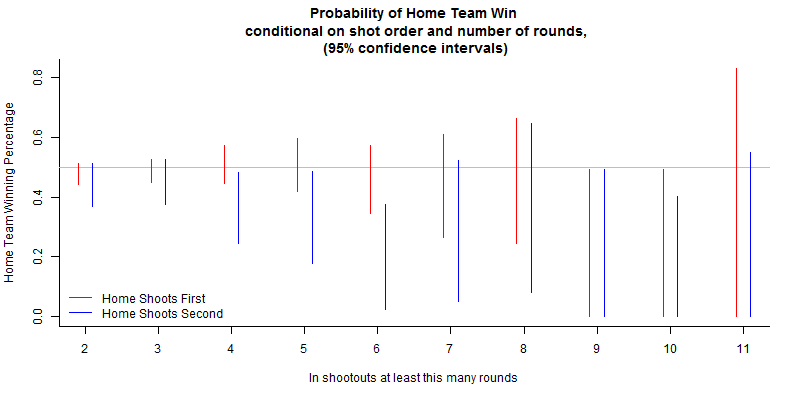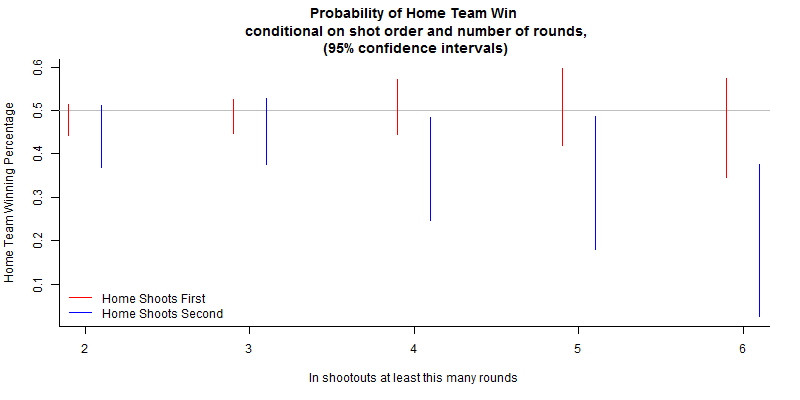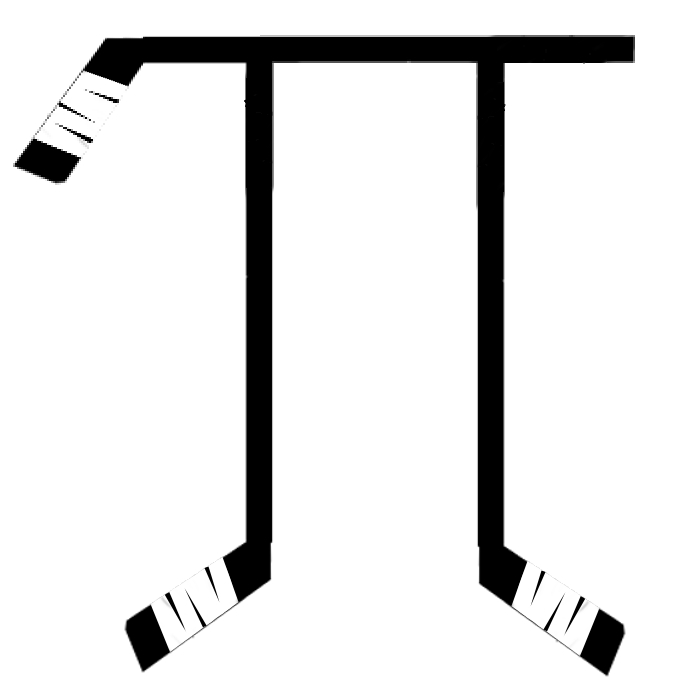Should you shoot first or second in a shootout?
July 15, 2013
I’ve always been interested in the strategy that goes into shootouts in the NHL. Each coach must first choose three players to take the shootout attempts for their team, and then they have to decide the ordering of those players. In addition, the home team gets to decide whether to shoot first or second.
80% of the time, the home team chooses to shoot first in the shootout. In terms of strategy, this seems like the proper course of action. Somebody better versed in economic game theory could probably prove this better than me, but the basic intuition is based on the fact that the probability of scoring on any shootout shot is less than 50%. If the team that shoots first scores, then the other team’s shooter probably feels more pressure to score. Likewise, if the first team fails to score, the odds are still in that team’s favor that the shootout score will remain tied (since there’s still less than 50% chance of the second team to score).
In this post, I want to see whether the team that shoots first actually wins more shootouts. By looking at the 900+ shootouts that have happened in the NHL since 2007-2008, I find that there appears to be some evidence that shooting first gives you a slightly better probability of winning. Somewhat surprisingly though, I also find that teams tend to do worse in shootouts at home than on the road.
In the 924 shootouts in my dataset, the most longest one lasted for 13 rounds. The “Number with this many rounds” column of the table below shows how many shootouts ended with as many rounds indicated on the far left. The table also shows (in the “Cumulative Number” column) the total number of shootouts that lasted at least as long as the round number on the far left.
|
Round
|
Number with this many rounds
|
Number with at least this many rounds
|
Home team wins in shootouts with at
least this many rounds
|
Home team winning percentage
|
|
2
|
110
|
924
|
435
|
47.1%
|
|
3
|
513
|
814
|
390
|
47.9%
|
|
4
|
141
|
301
|
144
|
47.8%
|
|
5
|
66
|
160
|
75
|
46.9%
|
|
6
|
48
|
94
|
38
|
40.4%
|
|
7
|
13
|
46
|
18
|
39.1%
|
|
8
|
15
|
33
|
14
|
42.4%
|
|
9
|
2
|
18
|
4
|
22.2%
|
|
10
|
6
|
16
|
3
|
18.8%
|
|
11
|
6
|
10
|
3
|
30.0%
|
|
12
|
3
|
4
|
1
|
25.0%
|
|
13
|
1
|
1
|
0
|
0.00%
|
What jumps out from this table is that, regardless of how long the shootout lasts, the home team wins the game less than half of the time. My best guess for why this is the case is that home teams might be slightly more likely to win the game during the 5 minute overtime period. Away teams might play more conservatively in overtime, so that they can have a chance to win in the shootout, where the final outcome is potentially more random.
I indicated above that the home team opts to go first in the shootout roughly 80% of the time. This might lead you to jump to the conclusion that the going first in the shootout is a disadvantage. What I hope to convince you of now is that this conclusion is wrong.
Overall, the home team wins the shootout 47.1% of the time. In games where they shoot first, the home team has a winning percentage of 47.8%. When they opt to go second, however, the home team’s winning percentage falls to 44.0%. It’s as if the home team is less likely to win a shootout in general, but they’re at an even bigger disadvantage when they choose to shoot second.
The graph below shows the winning percentages of the home team, depending on whether they shot first or second in the shootout. There’s no need for me to talk specifically about the away team winning percentages, since they’re equal to one minus the home team percentage. Each pair of red and blue bars corresponds with the percentages (and 95% confidence intervals) calculated based on all shootouts that lasted at least as many rounds as indicated on the bottom, x axis.

What we’re looking for here are situations in which a particular pair in which the red and blue bars do not overlap with each other. This serves as a visual check for whether there is a statistically significant difference in the home team winning percentage between when they shoot first or second.
As is obvious, there’s no instances in which a pair of bars does not overlap. However, I’m not willing to completely strike out the possibility that shooting first gives you a better chance at winning than shooting second. The figure below is identical to the previous one, except that I’ve zoomed in on the shootouts that lasted 6 or fewer rounds. I chose eliminate the 7+ round shootouts from the graph because that half of the graph is based on only a handful of data points, since only 13 shootouts lasted longer than 6 rounds.

Looking at this zoomed in graph appears to tell a more interesting story. In shootouts that are won in either two or three rounds, the confidence interval pairs completely overlap with each other and all four bars cross 50%. This indicates to me that it doesn’t really seem to matter who went first or second in shootouts that are done after 3 rounds.
But look at the bars for shootouts lasting 4, 5, or 6 rounds. To me, these seem in indicate that a team is worse off shooting second. I say this because the blue bars seem to have a downward trajectory, the red bars have a slight upward trajectory, and the amount of overlap for each pair gets smaller and smaller.
Trying to get estimates for difference in winning percentages based on shot order is pretty straightforward statistically. Based on my data I estimate that, for all shootouts, opting to shoot first has an effect on your winning percentage somewhere between increasing it by 11.8% and decreasing it by 4.2%. This is a classic instance of failing to reject the “null hypothesis” of there being no effect in shooting order. With longer shootouts, however, I am able to reject the null hypothesis. In shootouts lasting at least four rounds, I estimate that the team shooting first is between 0.8% and 27.8% more likely to win than if they had shot second.
Here’s the takeaway: If I were advising an NHL head coach, I’d tell him that if the shootout only lasts three rounds (which it typically does) it probably doesn’t matter whether you choose to go first or second. But if it goes beyond the initial three rounds, there’s evidence that you’re better off shooting first. So because of that, you should always, always, always shoot first. At worst, it doesn’t matter whether you went first of second. At best, it gives you a strategic advantage in late rounds of the shootout.

